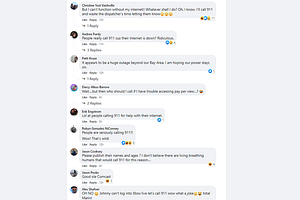
Dear Ms. Smartphone: My parent’s neighbor has an older phone that plugs into the wall. She lost power when the phone lines went down last month and is worried now that phones don’t work in an emergency. I have a cell phone and during that outage the calls got jammed. But we used a computer and Nextdoor to figure out what was going on. How can I help this neighbor get better prepared next time? Alix, Belvedere
Dear Alix: It’s great that you are thinking forward and helping neighbors! Some communities have a watch list for those in need, particularly useful when phones won’t work in an emergency and there’s a need to evacuate. Hopefully that is not foreseeable.
For now, investigate whether her old style phone is hard wired into the wall, or is a more modern device that plugs into a wall jack with Voice over Internet Protocol (VOIP). Telzio says, looks-wise, VOIP phones and analog phones are indistinguishable to the average person and provide the same functionality.
People with VOIP phones think they are safe because they plug into a wall jack. But they are often in triple jeopardy in an emergency. These phones need electricity, fresh batteries, and wireless to work. Until recently, the analog old style hard-wired corded phones had ~ 98.9% reliability. There was a resilient network of copper cables that transmitted voice calls outside the home and office. But today, we send and receive so much more- zoom, video games, banking, shopping, movies. To deliver that bandwidth most of the copper cable has been replaced with wireless transmission, fiber optic cable, and satellite service. Telcos sometimes use these too between their own trunk lines and switching offices.
That is all good- until it is not. In an emergency, say an earthquake or severe wind storm, the old phone system called POTS (plain old telephone service) delivered when electricity failed. Today, the price we pay for speedy bandwidth is occasional inconsistency due to the interdependence of phones and electrical service. It’s an issue recognized by the FCC and lawmakers. After the 2019 fires, a State Bill was introduced to make sure that wireless companies, Comcast, AT&T, et al. provide 72 hours of backup electrical service at their cell towers.
Ongoing:
It’s not just emergencies. The California Office of Emergency Services reports that, on average, there are 15 outages and 255 hours of downtown a month. Most of these don’t create a public disturbance until they go on for extended periods, or in extreme cases, they immobilize calls to ‘911’.
There appears to have been a cascade like effect during the incident you mention. The damaged cable was connected to a bigger line (called a trunk) and then caused it to fail. People at home tried to use their phones to get Internet service, say as a hotspot. People on the Internet used their computers to make voice calls, say over Skype. We were all transmitting over a reduced bandwidth of fiber optics and cell towers until eventually there was ‘radio silence.’
Scraping By:
As you mention those who could still get Internet service turned to social media to find out what was going on. The local newspaper, The Ark reports, that a San Francisco company called “Downdetector” (Parent company Ookla in Seattle, Wa.) was scraping these posts to tabulate the severity of the outage for Verizon, Comcast, and AT&T! It’s ironic that they were using the Internet to gather customer data!
During the phone outage others called into the local police stations or to 911. That began to overwhelm the emergency service lines and compound the problem. Marin has become sort of a poster child on social media for its inappropriate use of 911 calls that day (see image). It’s not clear that your neighbor’s analog phone would have had greater priority reaching 911 once transmissions got overloaded.
On a personal level, one of the lessons I learned after the 2019 fires was that while many lost electricity for days, there was no PG&E outage just a few miles away in the City. In light of my transportation background, my advice is to keep your car topped off with a full tank. Alternatively, keep your electric car on alert with a full charge so you can also use it to power up your home! Use the car radio to listen for updates and when it sounds safe, seek higher ground. The key is figuring out what communities have working electricity. While the electronic tolling on the bridges should be free that day (!) there is real risk from traffic backups and traffic signal outages.


Leave a Reply
You must be logged in to post a comment.